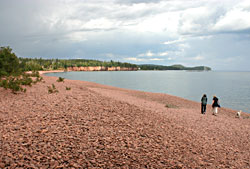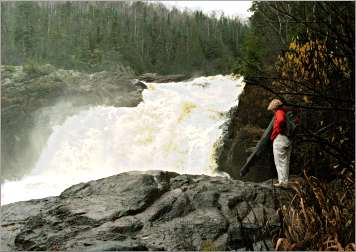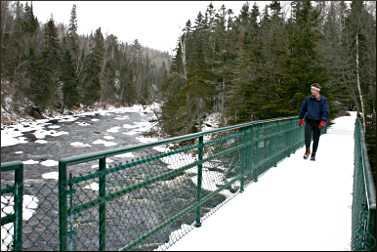Quiet time on Minnesota's North Shore
Late fall is marked by stark beauty, cheaper stays and the gales of November.

© Beth Gauper
The skies were leaden and forbidding as Lake Superior slid into view and we descended into Duluth. The wind mauled our hair as we stood alongside the harbor canal, waving to the crew of the Sea Pearl II as it pushed toward Malta with a load of grain.
Driving up the shore, we listened to taped stories of shipwrecks: The sidewheeler Lotta Bernard, pummeled into pieces off Gooseberry Falls on Oct. 29, 1874.
The steamer Edenborn, hurled into the mouth of Split Rock River and broken in two on Nov. 28, 1905. The Lafayette, pulverized against a cliff near Encampment Island on the same day.
Ahhhh. This is the North Shore I know and love.
Late fall and early winter are good times to visit this moody coast. Frosts harden mud on hiking trails. The leaves of aspen and birch fall aside like a curtain, revealing fresh views of waterfalls and gorges.
The famous gales of November promise drama on the lake, to be watched from cozy rooms whose price has dropped nearly by half till ski season.
Late one October, a girlfriend and I tramped our way up and down the shore, where the temperature was a balmy 50 degrees and people in Grand Marais were walking around in shorts.
It wasn't yet deer-hunting season, but we stuck to the state parks — seven of them strung along the shore, around the mouths of rivers whose roaring torrents are mementos of the Ice Age.
We started at Tettegouche, walking along the Baptism River and admiring the fat clusters of bright-red mountain-ash berries brightening the stark landscape. Soon the path merged with the Superior Hiking Trail.
We came out on High Falls, coursing creamy-gold down a black basalt face, and crossed a suspension bridge on our way to Two Steps Falls.

© Beth Gauper
At the next park, we followed the tortuous course of the Temperance River, seething and twisting like a flume ride from hell. Here, pebbles in the swirling water have scraped potholes in the riverbed and in the sides of the gorge.
A plaque explained that shoreline beaches of glacial Lake Duluth still can be found in the woods, 500 feet above the present lake.
On the way back, we stopped to watch a plump little grouse picking its way through the underbrush. It was grouse-hunting season, but the bird wasn't worried; when we finally walked on, it was still there.
The century-old fishing village of Tofte is just down the road, so we stopped at its North Shore Commercial Fishing Museum, a replica of the twin fish house built by the Norwegian brothers who were the first settlers.
The interior smelled lavishly of fresh pine, not the "cedar, dried fish, linseed oil and manila rope" of the original. Yet photos and equipment — a herring shovel, gill nets, the 1912 Mackinaw boat Isle — evoked an era that ended in the 1950s with the invasion of the lamprey eel.
Then the lights went out, heralding a cloudburst. We were glad to duck into our warm hotel room in Grand Marais.
The next morning, a few orange rays glowed in the sky, but familiar gray had regained its hold by the time we headed north for Judge C.R. Magney, a park named for the populist who proclaimed, "Our state parks are everyman's country estate."
We climbed a pebble trail, drawn like spawning salmon to yet another mighty river: the Brule, which crashed over two ledges with a deafening roar.
"If it's like this in the fall, what would it be like in the spring?" asked my friend, enveloped in billows of mist. Upstream is the Devil's Kettle, a portion of river that disappears into a fabled black hole; the water was high, however, and it was hard to see.
Back at the southern end of the shore, we stopped at Gooseberry Falls. The cascades down the wide rocky gorge, twisted cedars clinging to its sides, were so gorgeous that we followed the trail toward the lake, to see them again from the opposite ridge.
Then the skies darkened, and as we drove home we got caught in a blinding fusillade of rain. But it vanished, a nail-biting half-hour later, as swiftly as it came.
Beauty, with a hint of menace — that's the North Shore I know and love.
Trip Tips: Quiet time on Minnesota's North Shore

© Beth Gauper
Accommodations: Rates drop the last weekend of October and stay low until Christmas/ski season. Often, the places with the most rooms to sell offer the best deals.
For a list of accommodations, see Where to stay on Minnesota's North Shore.
Events: Nov. 10, lighting of the Split Rock Lighthouse beacon to commemorate the sinking of the Edmund Fitzgerald. There's a 4:30 p.m. ceremony, during which the names of the 29 lost crewmen are read, and then the beacon is lighted.
For more, see Gales of November.
State parks: Gooseberry is at mile marker 39.5 (distance from Duluth); Split Rock, 46; Tettegouche, 58.5; Temperance River, 81.4; Cascade River, 99.8; Judge C.R. Magney, 123.8; Grand Portage, 150.
For more, see North Shore by the mile.
Deer-hunting firearms season: Minnesota's two-week season starts the first Saturday of November.
Hiking: During the firearms season, the Superior Hiking Trail Association closes the Lake County section of the trail, from Knife River to just beyond Little Marais.
For details about closures, wildlife activity and trail conditions, check its Conditions page. Wet and muddy conditions also can close trails.
It's a good idea to wear blaze orange or other bright colors while hiking anywhere in the north woods in fall. In September and October, gun hunters are out seeking grouse, bear and moose, and archers hunt deer.
To be safest during firearms season, hike in state parks on the lake side of Minnesota 61 or, better yet, in Duluth.
For more, see Hiking in Duluth.